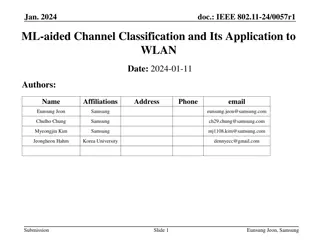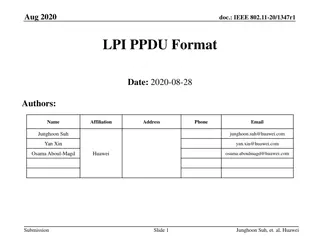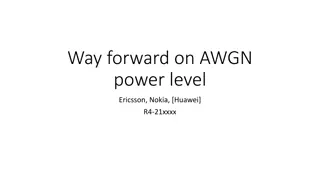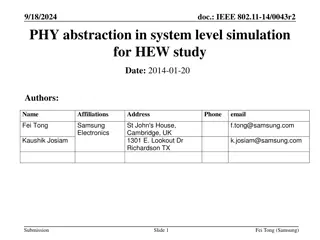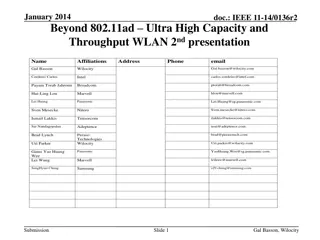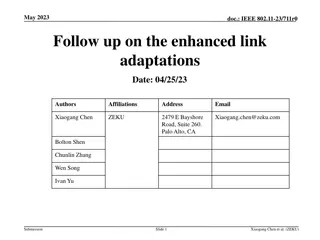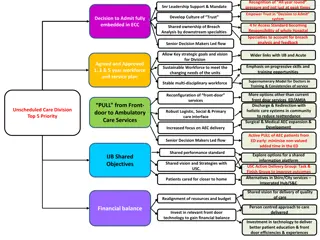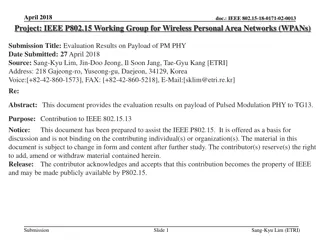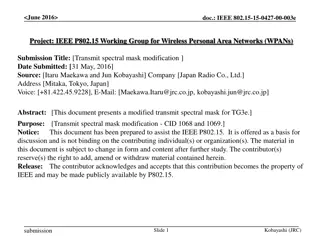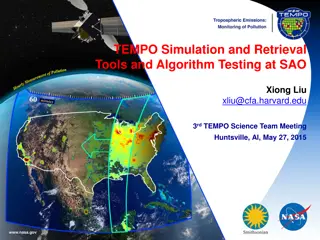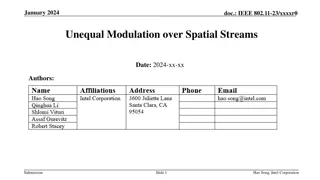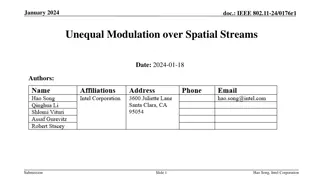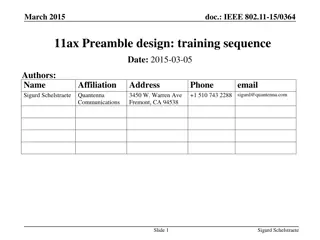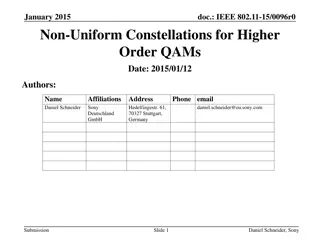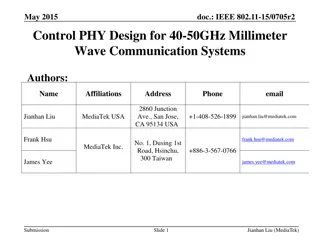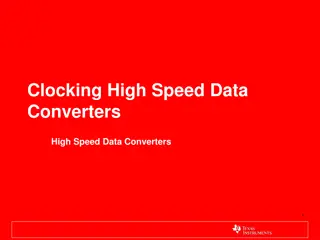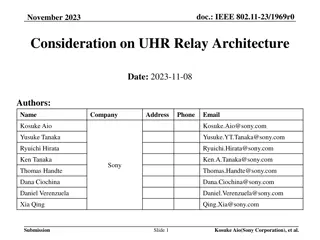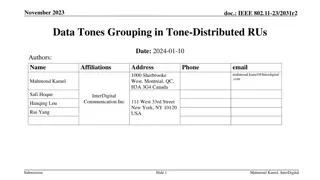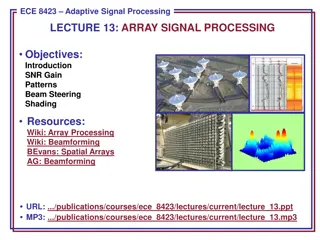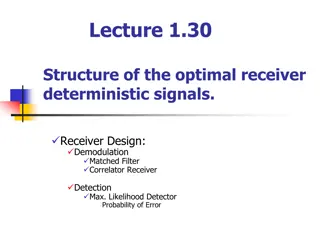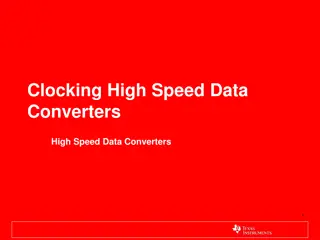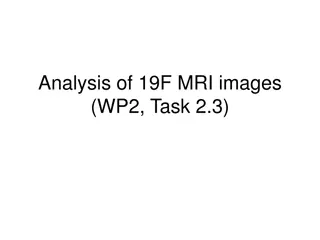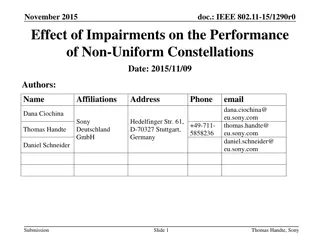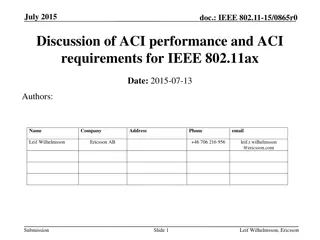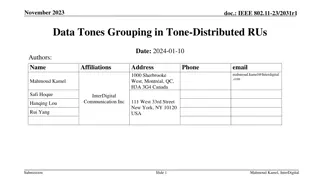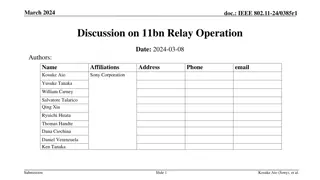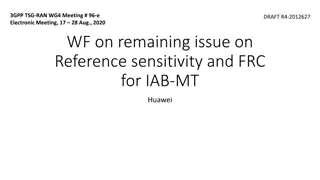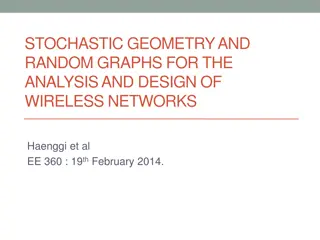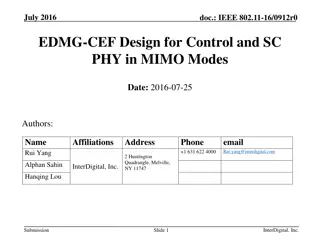ML-Aided Channel Classification for WLAN Optimization
The paper discusses using machine learning to classify IEEE channel models and improve WLAN performance. It demonstrates how neural networks can accurately classify channel types, leading to efficient beamforming and signal processing. Simulation results show the classification performance even at l
1 views • 12 slides
Proposed 80 MHz EHT LPI PPDU Format for IEEE 802.11-20/1347r1
The document presents the proposed LPI PPDU format for IEEE 802.11-20/1347r1, focusing on enhancing the robustness of the preamble and payload in non-OFDMA frames. The format includes repetitions of U-SIG and E-SIG symbols, optimizing DCM gain for improved performance. Simulation results show advant
0 views • 12 slides
AWGN Power Level in Telecom Standards
Explore the impact of AWGN power level variations in Ericsson, Nokia, and Huawei technologies as per R4-21xxxx specifications. Learn how adjustments in AWGN offset affect test validity and baseband SNR levels according to standard notes 4 and 5 in 38.141-1 and 38.141-2. Discover upcoming changes in
0 views • 4 slides
System-Level Simulation for HEW Study in IEEE 802.11-14/0043r2
This document discusses abstraction in system-level simulation for High-Efficiency Wireless (HEW) study, focusing on effective Signal-to-Noise Ratio (SNR) mapping, parameter fitting, selection of mapping functions, and simulation conditions/assumptions for IEEE 802.11. The study explores various met
1 views • 25 slides
Beyond 802.11ad: Ultra High Capacity and Throughput WLAN
The document from January 2014 discusses the exploration of modifications to IEEE 802.11ad-2012 PHY and MAC layers to enable modes of operation in the 60 GHz band capable of achieving a maximum throughput of at least 30 Gbps while maintaining the band's excellent capacity attributes. Topics include
0 views • 21 slides
IEEE 802.11-23/711r0 May 2023 Document Summary: Enhanced Link Adaptation Discussions
The May 2023 document IEEE 802.11-23/711r0 discusses topics like beamforming feedback, closed-loop rate adaptations, and issues related to beamforming feedback in a wireless communication context. It elaborates on the challenges of feedback optimization and post-SNR degradation, suggesting solutions
0 views • 15 slides
Comprehensive Healthcare Strategy for Sustainable Improvement
Recognizing year-round pressures, this healthcare strategy emphasizes Snr Leadership support, Decision to Admit system, Trust culture, and shared responsibility in breach analysis. It aims to enhance workforce sustainability, improve patient care pathways, and achieve efficiency through technology i
0 views • 7 slides
Evaluation Results on Payload of Pulsed Modulation PHY for IEEE 802.15-18-0171-02-0013
This document presents the evaluation results on the payload of Pulsed Modulation PHY for TG13, focusing on detection probability, BER vs SNR for header and payload, and coding considerations. It discusses the application of RS code for payload simulations and highlights the adjustments made for suc
0 views • 21 slides
Modified Transmit Spectral Mask for IEEE P802.15 Working Group
This submission presents a modified transmit spectral mask for TG3e by Japan Radio Co., Ltd. The proposed mask aims to improve power efficiency without violating radio regulations. The motivation for the modification is to reduce unwanted aliasing and enhance SNR by employing a steep anti-aliasing s
0 views • 17 slides
Simulation Results for LC-Optimized PHY Proposal in July 2019
The document presents simulation results for an LC-optimized PHY proposal for TGbb based on G.9991 PHY. It includes details on the simulation setup, frame detection results, header modulation, coding simulation results, payload modulation, and coding simulation results. The setup involved various re
1 views • 18 slides
TEMPO Simulation and Retrieval Tools Testing at SAO
TEMPO Simulation and Retrieval Tools and Algorithm Testing at SAO involved performing retrieval sensitivity studies, adapting VLIDORT for TEMPO radiance spectra, utilizing TEMPO SNR model for optical transmission calculations, and using climatological a priori data for trace gases. The studies focus
0 views • 4 slides
Comparison of Unequal Modulation and Unequal MCS in IEEE 802.11-23
The comparison between Unequal Modulation and Unequal MCS in the context of IEEE 802.11-23 discusses how these techniques handle spatial streams, modulation schemes, and coding rates to optimize throughput and MIMO gains. Unequal Modulation focuses on adjusting modulations per stream based on SNR co
0 views • 10 slides
Maximizing Throughput in IEEE 802.11 Networks Through Unequal Modulation Strategies
The documents discuss the benefits of using unequal modulation over spatial streams in IEEE 802.11 networks to enhance throughput. Unequal modulation allows for adapting modulation schemes based on Signal-to-Noise Ratio (SNR) conditions, optimizing MIMO gains and coding rates for each spatial stream
0 views • 10 slides
IEEE 802.11-15/0364: Channel Estimation Considerations in Wi-Fi Standards
Channel estimation in IEEE 802.11 standards, such as 11n, 11ac, and 11ax, is crucial for efficient MIMO systems. The noise impact during data reception affects the quality of the channel estimate, leading to SNR reduction post-equalizer. Techniques like channel smoothing and averaging of training se
0 views • 11 slides
Non-Uniform Constellations for Higher Order QAMs in January 2015
Non-uniform constellations (NUCs) offer improved performance compared to uniform constellations (UCs) in the context of higher order QAMs discussed as potential technology for next-generation 60GHz OFDM. The use of NUCs optimizes the location of constellation points, ensuring robust and weak bits ca
0 views • 10 slides
Designing Control PHY for Millimeter Wave Communication Systems
Proposal for designing a Control PHY with low complexity and high performance for 40-50GHz millimeter wave communication systems. Focus on beamforming requirements, antenna gain, modulation schemes, spreading with Barker Sequences, and SNR enhancement. Emphasis on signal processing techniques to imp
2 views • 16 slides
How 802.11ba Handled SNR
The document delves into how IEEE 802.11ba manages Signal-to-Noise Ratio (SNR) requirements, comparing them to other standards, defining SNR bandwidth, channel models used, receiver noise figure, and transmit power considerations.
0 views • 12 slides
EliMO: Eliminating Channel Feedback from MIMO
This study explores the elimination of explicit CSI feedback in MIMO systems for WiFi beamforming to achieve high throughput. It introduces EliMO, a two-way CSI estimation protocol, comparing it with implicit and explicit feedback methods. The research focuses on downlink and uplink CSI estimation t
0 views • 19 slides
Wireless Networking - III: MIMO and Beamforming
The content delves into MIMO (Multiple Input Multiple Output) technology, beamforming, and wireless network capacity enhancement. It discusses 802.11 standards, wireless channel capacity, methods to increase capacity, multiple antenna systems, and the implications of increasing SNR and transmission
0 views • 81 slides
Maximizing SNR in High-Speed Data Converters
Strategies for maximizing the Signal-to-Noise Ratio (SNR) in high-speed data converters. Learn about key factors affecting SNR, such as quantization noise, clock jitter, and thermal noise. Understand methods to increase SNR by managing signal power, noise sources, and ADC performance. Discover how t
0 views • 51 slides
IEEE 802.11-17/0784r0 Wi-Fi Enhancement for Full Coverage at Smart Home: Part-I
This presentation explores the coverage issues of current IEEE 802.11 wireless LAN in smart homes, emphasizing the need for full coverage. It introduces narrow-band transmission to enhance signal-to-noise ratio (SNR) for improved coverage. The analysis assumes a Wi-Fi system operating on 2.4GHz or 5
1 views • 29 slides
Enhancing Wireless Communication Through UHR Relay Architecture
The document discusses the significance of relay communication in improving Rate-vs-Range throughput in wireless networks. It explores the effectiveness of relay communication for enabling communication between Access Points (APs) and Stations (STAs) and enhancing throughput by improving Signal-to-N
0 views • 14 slides
Improving Wireless Network Performance Through Data Tones Grouping
Explore the benefits of data tones grouping in Tone-Distributed Resource Units (dRUs) for enhancing Packet Error Rate (PER) performance in IEEE 802.11 networks. Discover different methods of grouping data tones and how this optimization can impact channel bandwidth and signal quality. Learn how pilo
0 views • 20 slides
Understanding Array Signal Processing: Enhancing SNR and Directivity
Array signal processing involves applying techniques to groups of sensors to improve SNR, discern directionality between signals and interferences, and optimize signal tracking. This lecture covers basic properties, SNR gain by summation, and sensitivity patterns for sensor arrays.
0 views • 10 slides
Optimal Receiver Design and Error Sources in Signal Processing
Explore the structure of optimal receivers for deterministic signals, demodulation techniques, detection methods, and sources of errors in received signals. Discover the steps in designing receivers to maximize SNR and minimize ISI.
0 views • 25 slides
Understanding Clocking and Data Converters for Improved ADC Performance
Learn about clocking solutions, signal-to-noise ratio basics, maximizing SNR in ADCs, individual contributors to SNR, quantization noise, and more to enhance your understanding of high-speed data converters and optimize ADC performance.
0 views • 51 slides
Advanced Analysis of 19F MRI Images for Fluorinated Tracers Study
Explore the innovative strategies and technologies used in the analysis of 19F MRI images to evaluate the bio-distribution of fluorinated tracers in patients. The utilization of SNR optimization, DNN-based denoisers, and automatic segmentation methods highlights the progress in enhancing image quali
0 views • 5 slides
Performance of Non-Uniform Constellations in SC Modulation with Impairments
Explore the impact of impairments on non-uniform constellations (NUCs) in single-carrier (SC) modulation. The study delves into NUCs with 64 signal points under various impairments like ADC quantization and fading channels, revealing robustness and potential gains. Discover how NUCs compare to unifo
0 views • 14 slides
Discussion on REFSENS Requirements for NR V2X UE Bands
RAN4 meeting focusing on setting target SNR points and Noise Figure for NR V2X UE at licensed/unlicensed bands, with options proposed based on simulation results and MCS settings. Parameters like diversity gain and RB size have been established. Decision-making process outlined for Noise Figure cons
0 views • 7 slides
Performance Analysis of Outer Reed Solomon Coding Scheme IEEE 802.11-19/0364r0
Explore the performance analysis of the Outer Reed Solomon coding scheme for IEEE 802.11-19/0364r0, focusing on metrics like PER, throughput, Eb/N0, SNR, MCS, and channels. The study delves into coding rates, AWGN, LoS, NLoS scenarios, and the impact on various modulation schemes such as BPSK, QPSK,
0 views • 14 slides
Enhancing Performance of Hybrid-ARQ with Linear Constellation Precoding
Explore a novel hybrid-ARQ scheme using linear constellation precoding that outperforms existing schemes like Code combining and Constellation rearrangement. The scheme shows improved packet error rate performance and transmission throughput across various SNR values. Discover the detailed compariso
0 views • 16 slides
Understanding ACI Performance & Requirements in IEEE 802.11ax
Explore the discussion on Adjacent Channel Interference (ACI) performance as determined by Adjacent Channel Leakage Ratio (ACLR) and Adjacent Channel Selection (ACS). Comparisons with LTE, evaluation methodologies, and possible improvements are covered for IEEE 802.11ax. Terminology, required effect
0 views • 19 slides
Real-Time Digital Signal Processing Laboratory Course Overview
Explore the course objectives, design flow, signal processing building blocks, and signal quality measures in the context of real-time digital signal processing. Gain insights into tradeoffs in signal quality versus runtime implementation complexity, receiver design methods, communication systems, a
0 views • 24 slides
IEEE 802.11-23/2031r1 Data Tones Grouping in Tone-Distributed RUs
Explore the concept of grouping data tones in Tone-Distributed Resource Units (dRUs) for improved performance in long-range communication scenarios within the context of IEEE 802.11 standards. Methods of data tones grouping, pilot tone impact, and considerations for dRUs are discussed, offering insi
0 views • 20 slides
Enhancing Throughput with IEEE 802.11bn Relay Operation
Explore the proposal for 11bn Relay Operation in IEEE 802.11 to enhance rate-vs-range throughput, improve SNR, and enable effective communication. Learn about the current relay operations and the basic proposal for relay operation advancements.
0 views • 16 slides
Remaining Issue on Reference Sensitivity and FRC for IAB-MT by Huawei
Explore agreements and parameters discussed in 3GPP.TSG-RAN.WG4 Meeting #96-e regarding Reference Sensitivity and FRC for IAB-MT by Huawei. Details on SNR, FRC exclusion, and more for FR1 and FR2, along with FRC parameters are provided.
1 views • 4 slides
Analysis and Design of Wireless Networks with Stochastic Geometry
Explore the application of stochastic geometry and random graphs in the analysis and design of wireless networks, focusing on SNR, SINR, Poisson point processes, random graph models, and interference characterization.
0 views • 15 slides
Smart Lighting in Electrical Engineering: VLC Applications & Learning Insights
Explore the world of Smart Lighting in Electrical Engineering through the VLC Applications module at Boston University. Gain insights on topics such as SNR, Polarity, Ohm's Law, Photodiodes, Soldering, and more. Enhance your knowledge in wired vs. wireless communications, electromagnetic spectrum, v
1 views • 16 slides
IEEE 802.11-16/0912r0 EDMG-CEF Design for MIMO Modes
In this contribution, two EDMG-CEF design options for control and single carrier PHY to support 11ay SU and MU MIMO are proposed. The document discusses the background, properties of CEF in 11ad, variants of 11ad CEF, and more, aiming to enable MIMO schemes effectively within the specified formats.
1 views • 13 slides
Millimeter Wave Communication Control PHY Design Overview
Explore the design requirements and considerations for Control PHY in 40-50GHz millimeter wave communication systems. The proposal focuses on implementing a Control PHY with low complexity and high performance, essential for supporting beamforming in challenging SNR environments. Details include bea
1 views • 16 slides
